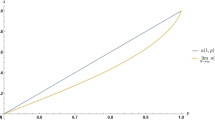Abstract
In this paper, we discuss in a general framework the design-based estimation of population parameters when sensitive data are collected by randomized response techniques. We show in close detail the procedure for estimating the distribution function of a sensitive quantitative variable and how to estimate simultaneously the population prevalence of individuals bearing a stigmatizing attribute and the distribution function for the members belonging to the hidden group. The randomized response devices by Greenberg et al. (J Am Stat Assoc 66:243–250, 1971), Franklin (Commun Stat Theory Methods 18:489–505, 1989), and Singh et al. (Aust NZ J Stat 40:291–297 1998) are here considered as data-gathering tools.
Similar content being viewed by others
References
Agrawal R, Srikant R (2000) Privacy-preserving data mining. In: Proceedings of the 2000 ACM SIGMOD international conference on management of data and symposium on principles of database systems, Dallas (USA), 15–18 May 2000
Arnab R (1996) Randomized response trials: a unified approach for qualitative data. Commun Stat Theory Methods 25:1173–1183
Arnab R, Singh S (2002) Estimation of the size and the mean value of a stigmatized characteristic of a hidden gang in a finite population: a unified approach. Ann Inst Stat Math 54:659–666
Barabesi L (2008) A design-based randomized response procedure for the estimation of population proportion and sensitivity level. J Stat Plan Inference 138:2398–2408
Barabesi L, Franceschi S, Marcheselli M (2012) A randomized response procedure for multiple-sensitive questions. Stat Pap 53:703–718
Barabesi L, Marcheselli M (2006) A practical implementation and Bayesian estimation in Franklin’s randomized response procedure. Commun Stat Simul Comput 35:563–573
Barabesi L, Marcheselli M (2010) Bayesian estimation of proportion and sensitivity level in randomized response procedures. Metrika 72:75–88
Chambers RL, Dunstan R (1986) Estimating distribution functions from survey data. Biometrika 73:597–604
Chaudhuri A (1987) Randomized response surveys of finite populations: a unified approach with quantitative data. J Stat Plan Inference 15:157–165
Chaudhuri A (2011) Randomized response and indirect questioning techniques in surveys. Chapman & Hall/CRC, Boca Raton, FL
Chaudhuri A, Mukerjee R (1985) Optionally randomized response technique. Calcutta Stat Assoc Bull 34:225–229
Chaudhuri A, Mukerjee R (1988) Randomized response: theory and techniques. Marcel Dekker INC, New York
Chaudhuri A, Saha A (2005) Optimal versus compulsory randomized response techniques in complex surveys. J Stat Plan Inference 135:516–527
Chaudhuri A, Stenger H (2005) Survey sampling: theory and methods, 2nd edn. Chapman & Hall/CRC, Boca Raton, FL
Christofides TC (2005) Randomized response technique for two sensitive characteristics at the same time. Metrika 62:53–63
Diana G, Perri PF (2009) Estimating a sensitive proportion through randomized response procedures based on auxiliary information. Stat Pap 50:661–672
Diana G, Perri PF (2010) New scrambled response models for estimating the mean of a sensitive quantitative character. J Appl Stat 37:1875–1890
Diana G, Perri PF (2011) A class of estimators for quantitative sensitive data. Stat Pap 52:633–650
Fox JA, Tracy PE (1986) Randomized response: a method for sensitive survey. Sage Publication Inc, Newbury Park
Franklin LA (1989) A comparison of estimators for randomized response sampling with continuous distributions from a dichotomous population. Commun Stat Theory Methods 18:489–505
Greenberg BG, Kubler RR, Abernathy JR, Horvitz DG (1971) Applications of the randomized response technique in obtaining quantitative data. J Am Stat Assoc 66:243–250
Gupta S, Shabbir J, Sehra S (2010) Mean and sensitivity estimation in optional randomized response models. J Stat Plann Inference 140:2870–2874
Horvitz DG, Thompson DJ (1952) A generalization of sampling without replacement from a finite universe. J Am Stat Assoc 47:663–685
Hedayat AS, Sinha BK (1991) Design and inference in finite population sampling. Wiley, Toronto
Marcheselli M, Barabesi L (2006) A generalization of Huang’s randomized response procedure for the estimation of population proportion and sensitivity level. Metron LXIV:145–159
Perri PF (2008) Modified randomized devices for Simmons’ model. Model Assist Stat Appl 3:233–239
Saha A (2007) A simple randomized response technique in complex surveys. Metron LXV:59–66
Särndal C-E, Swensson B, Wretman J (1992) Model assisted survey sampling. Springer, New York
Singh HP, Singh S, Kozak M (2008) A family of estimators of finite-population distribution function using auxiliary information. Acta Applicandae Mathematicae 104:115–130
Singh R, Mangat NS (1996) Element of survey sampling. Kluwer, Dordrecht
Singh S (2003) Advanced sampling theory with applications, vol 2. Kluwer, Dordrecht
Singh S, Horn S, Chowdhury S (1998) Estimation of stigmatized characteristics of a hidden gang in finite population. Aust NZ J Stat 40:291–297
Singh S, Kim J-M, Jang H, Horn S (2011) Truncated Midzuno–Sen sampling schemes for estimating distribution functions. Commun Stat Simul Comput 40:1096–1110
Stehman SV, Nshinyabakobeje S (2000) Comparison of distribution function estimators for forestry applications following variable probability sampling. Environ Ecol Stat 7:301–321
Warner SL (1965) Randomized response: a survey technique for eliminating evasive answer bias. J Am Stat Assoc 60:63–69
Acknowledgments
The Authors wish to thank the two anonymous referees for their careful revision of the paper and constructive comments.
Author information
Authors and Affiliations
Corresponding author
Rights and permissions
About this article
Cite this article
Barabesi, L., Diana, G. & Perri, P.F. Design-based distribution function estimation for stigmatized populations. Metrika 76, 919–935 (2013). https://doi.org/10.1007/s00184-012-0424-6
Received:
Published:
Issue Date:
DOI: https://doi.org/10.1007/s00184-012-0424-6



